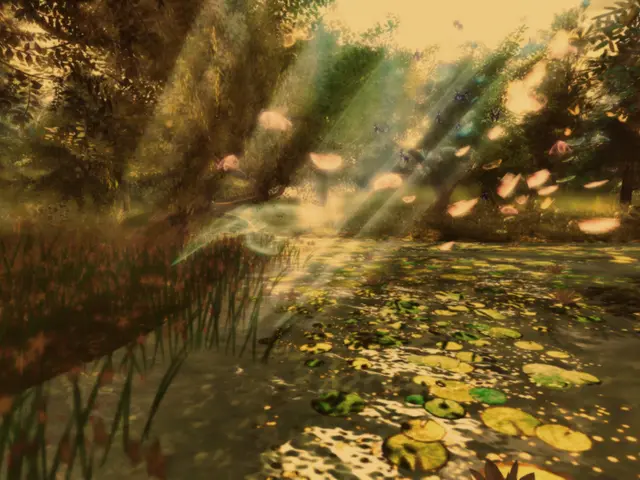Saturn's rings exhibit rainbows, and researchers might have figured out the source of this phenomenon
In a groundbreaking study published in the September 2025 issue of a renowned online publication, a team of researchers led by Professor Phil Nicholson from Cornell University has uncovered a fascinating phenomenon around Saturn's moon, Enceladus. The team, which includes Niels Rubbrecht, Stéphanie Cazaux, and others, discovered space rainbows around Enceladus, a discovery that has both scientific significance and a poetic beauty to it.
The space rainbows, visible in Cassini images, are created by sunlight reflecting off water-ice crystals with a smattering of carbon dioxide ice. The stripes, as they are aptly named, are likely the result of a reflection grating made up of particles from Enceladus' plumes. These particles responsible for the reflection grating are larger than those in Enceladus' plumes and are inclined far from Saturn's rings.
The stripes were only apparent in two Enceladus fly-bys, in December 2010 and May 2012, and were only visible in images taken by the Visual and Infrared Mapping Spectrometer (VIMS) and the visible Narrow-Angle Camera (NAC) on the Cassini probe. Interestingly, these stripes were not apparent in images from fly-bys of other moons such as Titan, Dione, Phoebe, and Tethys.
The separate bands making up the stripes appear to shift in position slightly when examined in different wavelengths of light. This observation, coupled with the consistent relative positions of these parallel stripes angled around 16° to the plane of the Solar System, suggests that this curious phenomenon persists for at least a year and a half.
The spectrum of the bright band produced by VIMS suggests that the material has been freshly ejected into space, further supporting the theory that these space rainbows are indeed a product of Enceladus' plumes.
Optical phenomena similar to those on Earth have been discovered in other worlds, such as a halo on Venus' upper cloud layer and hexagonal-shaped ice crystals in Martian clouds. This discovery around Enceladus adds to the growing body of evidence that such phenomena are not unique to our own planet.
The particles making up the diffuse E ring surrounding Saturn are also ice particles, further connecting these various optical phenomena.
This discovery of space rainbows around Enceladus is unprecedented and has sparked a renewed interest in the study of optical phenomena in space. The fountains of Enceladus, once thought to be mere geysers of water-ice, are now known to be capable of creating breathtaking displays of light and colour.
The study can be read online at arxiv.org/abs/2502.18028. This fascinating discovery is yet another testament to the Cassini mission's invaluable contribution to our understanding of the solar system.
Read also:
- "Eco-Scam": Unveiling the Truth about Electric Vehicles
- European transportation's sustainability and competitiveness rely on a "green industrial agreement" that serves the interests of both corporations and residents, as discussed in an Editorial from August 2024.
- Indian Oil Corporation's Panipat Refinery secures India's inaugural ISCC CORSIA accreditation for Sustainable Aviation Fuel production
- Porsche Macan Accelerates into Second Generation of Electric Power







